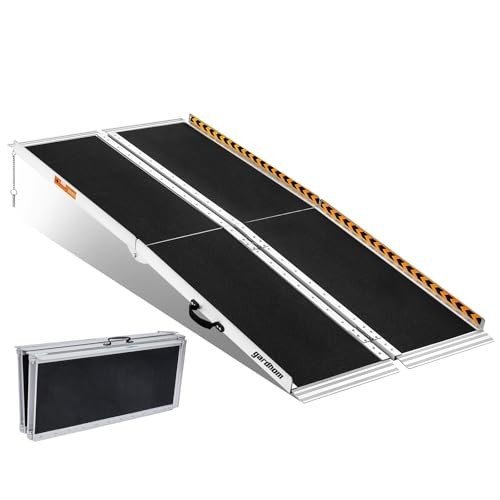
Wheelchair Ramps For Steps
Add a review FollowOverview
-
Founded Date 13/11/1911
-
Sectors Education
-
Posted Jobs 0
-
Viewed 5
Company Description
Your Family Will Thank You For Having This Disability Ramp

Understanding Disability Ramps: Essential Components for Accessibility
As societies increasingly recognize the importance of inclusivity, the requirement for accessible facilities has taken spotlight. Amongst the many adaptations that can be made to buildings and public spaces, disability ramps play an important function in making sure mobility for individuals with impairments. This blog site post will explore the basics of disability ramps, their types, material choices, codes and guidelines, best practices for setup, and common questions surrounding these important structures.
What is a Disability Ramp?
A disability ramp, often referred to as a wheelchair ramp, is a sloped surface developed to offer access to structures, automobiles, or other elevated areas for individuals with mobility impairments. These ramps are crucial for providing equal access and promoting independence for individuals with specials needs, the elderly, and others who may have problem with stairs.
Value of Disability Ramps
The main purpose of disability ramps is to help with movement and accessibility. Here are a couple of factors why they are important:
- Legal Compliance: Many nations have laws requiring public areas to be accessible to all individuals, consisting of those with impairments.
- Addition: Disability ramps get rid of barriers, helping individuals participate more completely in society.
- Security: Ramps minimize the danger of falls and mishaps compared to stairs, especially in unfavorable weather condition conditions.
| Value of Disability Ramps | Explanation |
|---|---|
| Legal Compliance | Required by law in lots of jurisdictions |
| Inclusion | Cultivates a sense of belonging and participation |
| Security | Reduces the risk of mishaps and falls |
Types of Disability Ramps
Disability ramps can be found in various forms, each fit to particular environments and requirements. Here’s a breakdown of typical types:
- Portable Ramps; https://www.donteodekirk.top,: Lightweight and easy to carry, these ramps are ideal for cars and temporary setups.
- Repaired Ramps: Installed permanently in structures or outdoor areas, repaired ramps are frequently made of concrete or metal.
- Threshold Ramps: Ideal for doorways, threshold ramps help with smoother shifts in between different surface area levels.
- Modular Ramps: These ramps are made from sections that can be adapted to fit different places, making them adjustable and flexible.
| Kind of Ramp | Description |
|---|---|
| Portable Ramps | Lightweight, movable, ideal for temporary usage |
| Repaired Ramps | Permanent installations for buildings or public locations |
| Threshold Ramps | Help with transitions at doorways |
| Modular Ramps | Personalized areas adaptable to different terrain and heights |
Products Used for Disability Ramps
The option of material for a disability ramp is crucial for safety, resilience, and aesthetic appeal. Common materials include:
- Wood: A popular choice due to its natural look, though it requires regular maintenance to avoid decay.
- Aluminum: Lightweight, rust-proof, and simple to install, aluminum ramps are an exceptional option for resilience.
- Concrete: Solid and long-lasting, concrete ramps are often utilized in fixed setups but require proper surface area treatment for security.
- Rubber: An ideal option for portable ramps, rubber offers exceptional traction and shock absorption.
| Material | Benefits | Downsides |
|---|---|---|
| Wood | Visually pleasing, personalized | Requires maintenance; can rot |
| Aluminum | Lightweight, rust-resistant, long lasting | Can be more pricey than other choices |
| Concrete | Strong, stable, perfect for permanent setups | Labor-intensive to install; requirements surface area treatment |
| Rubber | Exceptional traction, shock-absorbent | Might not be appropriate for all areas |
Regulations and Standards
Comprehending the policies surrounding disability ramps is essential for compliance and security. In the United States, the Americans with Disabilities Act (ADA) provides standards that consist of:
- Ramp Slope: The ADA suggests a slope ratio of 1:12 (one inch of height for every 12 inches of ramp length).
- Width: Ramps should be at least 36 inches broad to accommodate different mobility help.
- Landings: Level landings must be offered at the top and bottom of the ramp, in addition to at intervals along longer runs.
Table: ADA Requirements for Disability Ramps
| Function | Requirement |
|---|---|
| Ramp Slope | 1:12 ratio (1 inch vertical height = 12 inches length) |
| Minimum Width | 36 inches |
| Landing Length | Minimum of 60 inches on top and bottom |
| Surface Texture | Steady, firm, and slip-resistant |
Finest Practices for Installing Disability Ramps
When setting up a disability ramp, it’s vital to follow best practices to ensure safety and usability:
- Assess the Location: Determine the finest area for the ramp that complies with local laws and does not block access.
- Design for Purpose: Choose a ramp type and material that fits the specific requirements, such as property use or public access.
- Visual Indicators: Use color contrast and signage to make sure the ramp is noticeable and identifiable for users with visual impairments.
- Routine Maintenance: Inspect the ramp frequently to ensure it stays in excellent condition, looking for any indications of wear or damage.
Frequently Asked Questions (FAQ)
1. Who requires a disability ramp?
People using wheelchairs, walkers, or crutches, together with the senior or those recovering from injuries, can gain from disability ramps.
2. Can I build a disability ramp myself?
Yes, if you have the essential skills and tools. However, it’s suggested to speak with professionals or abide by local building regulations for safety.
3. How do I identify the length of the ramp?
The length of the ramp can be calculated based upon the height it needs to access, following the advised slope ratio of 1:12.
4. Are there funding options readily available for ramp setup?
Some non-profit organizations, federal government support programs, and community initiatives may provide financing or resources for structure accessible ramps.
5. What features should I think about for my ramp?
Think about the slope, width, surface area product, and security functions like hand rails, non-slip surfaces, and landings.
Disability ramps represent an important step in developing available environments for all individuals, especially those with mobility difficulties. Understanding the various types, products, policies, and finest practices for setting up disability ramps is crucial for guaranteeing security and compliance. As neighborhoods continue to make every effort for inclusivity, the installation of these ramps not just supports legal obligations however likewise promotes a culture that appreciates and values all members of society.

